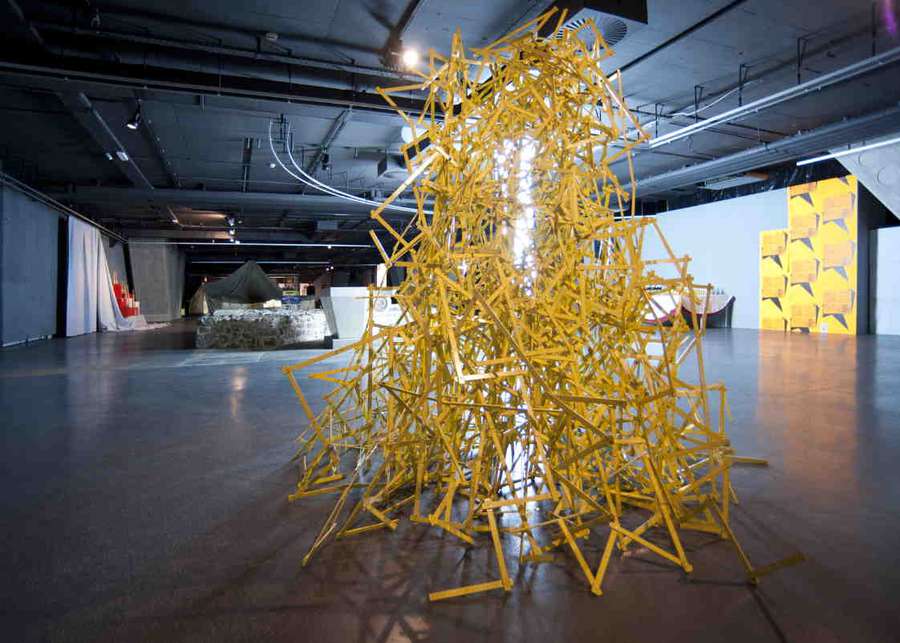Pavilion X
The exhibition tries to explore issues of context, connotation, and representation in reference to themes surrounding the German Pavilion.
Through installation-type and spatially orientated works, the aim is not a sociological, or political re-processing of the issue, but a sublime-associative, formal and poetic approach, allowing for multiple readings and opening a new space for reflection.
In architectural terms, a pavilion is a free-standing, open structure with various functions. Although already known and used in the Ancient World, in European architecture the pavilion came into use in the age of Absolutism, and was often an outbuilding of a castle, or in the parks and gardens of the aristocracy. Built either as a place of rest, a vantage point, or purely as a decorative element, pavilions became equally popular later on in the gardens of the affluent middle class for the same purposes. Music pavilions were then integrated into the public grounds of spa towns, and today, in contemporary architecture, most sport arenas display elements of pavilions.
In Asia, especially in Chinese architecture, the pavilion has a long tradition. In Japan, India, and Thailand elements of pavilions have been commonly used in religious buildings. In Buddhist temples, pavilions are used in many ways. However, the use of the pavilion is progressively changing and has come a long way from its previous sentimental associations of idyll and idleness in sanitised surroundings; pavilions are currently used worldwide as cheap prefabricated DIY products of temporary tarpaulin construction.
In the context of art, the word pavilion is associated with those in the Venice Biennale, where every two years over 70 nations re-design their individual pavilion with contemporary art. As early as 1907 the Belgian pavilion introduced the idea of representing a single nation with a single artist in an individual pavilion. The idea of combining national representation with the pavilion typology within a global art setting is a controversial and often discussed exhibition theme. It is seen as a reactionary, nation-orientated idea, which is at odds with a consolidated, globalised world. Moreover, the German Pavilion was redesigned in 1938 by the German architect Ernst Haiger, who replaced Greek ionic columns with rectangular pillars onto which he placed a flat architrave. In this way the pavilion, with its broad monumentality, became a reflection of The Third Reich itself. Ever since, the German Pavilion has been an ideologically impregnated building, providing a significant contextual framework not only through the structural language of the building, but equally through the consciousness of its purpose and past history. Even the British artist Liam Gillick’s take on the German Pavilion in 2009 showed that no exhibition or artistic contribution is possible without it being seen as a commentary on the building itself and its past.
The exhibition in the Jakopič gallery is the second part of a joint project of the Academy of Fine Arts and Design, University of Ljubljana and the Academy of Visual Arts Leipzig since 2009.
Colophon
Presented by: Hochschule für Grafik und Buchkunst – Academy of Visual Arts Leipzig, Academy of Fine Arts and Design Ljubljana, Museum and Galleries of Ljubljana
Coordination: Joachim Blank, Marija Skočir, Alen Ožbolt
Artists: Fabian Bechtle, Karl-Heinz Bernhardt, Chris Bierl, Corentin Canesson, Zaida Guerrero Casado, Liviu Dalateanu, Franziska Faust, Jay Gard, Sebastian Helms, Katya Lachowicz, Tobias Löffler, Anna George Lopez, Denis Luce, Tobias von Mach, Andreas Miller, Inga Martel, Wolf Konrad Roscher, Danny Schulz, Adrian Sievering, Ronny Szillo
Concept: Joachim Blank, Andreas Grahl
Location
Slovenska cesta 9
1000 Ljubljana
T +386 1 42 54 096
T +386 1 24 12 500
E galerija.jakopic@mgml.si
Opening hours
Tuesday–Sunday: 10 a.m.-6 p.m.
Monday: Closed
1 January, 1 November, 25 December: Closed
24 and 31 December: 10. a.m.-2 p.m.
Tickets
Adults: 5 €
Students, people over the age of 60, unemployed, people with disabilities: 3 €
Family ticket: 12 €
ICOM, PRESS, SMD, students of the Academy of Fine Arts and Design, VIST – Higher School of Applied Sciences, Faculty of Natural Sciences and Engineering – OTGO, Faculty of Design: Admission free
Guided tours of the exhibition: every Saturday at 4.30 p.m. (included in the admission fee)
Join the Friends of the Jakopič Gallery. The € 12 annual membership fee includes numerous benefits and exclusive events. Click here for more information.
